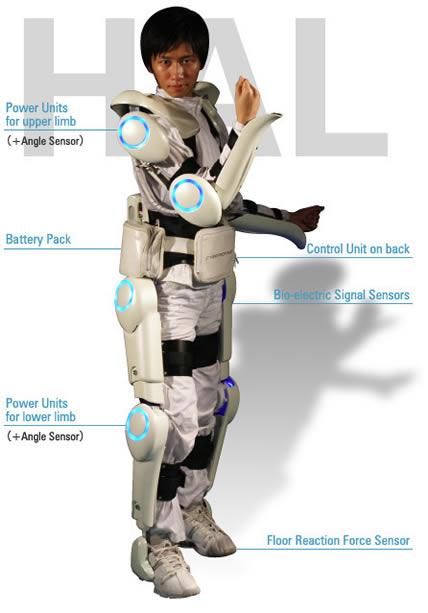"The sensors detect human intentions and finally, the robot walks instead of the human's body," says Professor Sankai.
Trials with HAL mounted on patients have been successful; case in point is that of Noboru Matsumoto who suffered severe brain injuries after a motorcycle crash thirty years ago. The accident left him with slurred speech and rendered him unable to walk properly, though he has some movement in his left leg. Doctors told he would never walk again.
 "Robot Suit HAL" is a cyborg-type robot that can expand and improve physical capability. Image Credit: CYBERDYNE
"Robot Suit HAL" is a cyborg-type robot that can expand and improve physical capability. Image Credit: CYBERDYNE
Professor Sankai saw hope for Matsumoto. Since Matsumoto has nerve function, he was the perfect patient to benefit from Professor Sankai's HAL suit. To demonstrate the "suit", the power was turned on and two nursing aides assisted Matsumoto as he pulled himself up. Matsumoto did the standing on his own.
When the steps came, tentative and small, Matsumoto had the gleeful smile on his face. It was easier to imagine what he looked like before his accident, as he put one foot in front of others. Matsumoto has used the robotic legs before at his rehabilitation clinic, but he never tires of the sensation of standing and walking.
"It's hard to explain," says Matsumoto, in halting English. "I'm very happy."
This positive transformation in the patient is what drives Professor Sankai, as he looks towards globalization of his invention. Currently there are 140 HAL suits in use in Japan, available on rent for approximately $2,000 a month. Professor Sankai is in the final stages of introducing these suits to Sweden and Denmark. He also hopes to be able to introduce the suits in the U.S., to help the aging baby boomers.
Public can catch a glimpse of other models of Professor Sankai’s HAL suit at his venture firm and R&D laboratory ‘Cyberdyne’.
According to Sankai he first drew inspiration from a book series he read, “I, Robot”, a collection of nine science fiction short stories by Isaac Asimov, first published in 1950.
The different models at the laboratory vary in size and purpose. There's a bulkier, full body suit aimed at giving caretakers superhuman strength to lift patients in nursing homes. Another variation is more scaled down; looking to a future when the robotic legs are so thin the patient could wear them underneath clothing.
While the professor's invention bears the same name as the on-board computer in the movie "2001: A Space Odyssey", the intention of all of the HAL suits, is benevolent.
Professor Sankai reveals that governments of the U.S. and South Korea have approached him to develop his robotic suits for military usage. He's turned down the offers of those governments, he says, because his inventions are only for peaceful purpose.
The choice is a simple one, says the professor, "their faces completely change," explained the Professor talking of the patients who have shown improvement using the HALs. "When I see these smiling faces, my heart is also encouraged."
Noboru Matsumoto is certainly smiling more, even as his physical therapy session comes to an end. "Hashiritai desu," says Matsumoto. "I want to run."